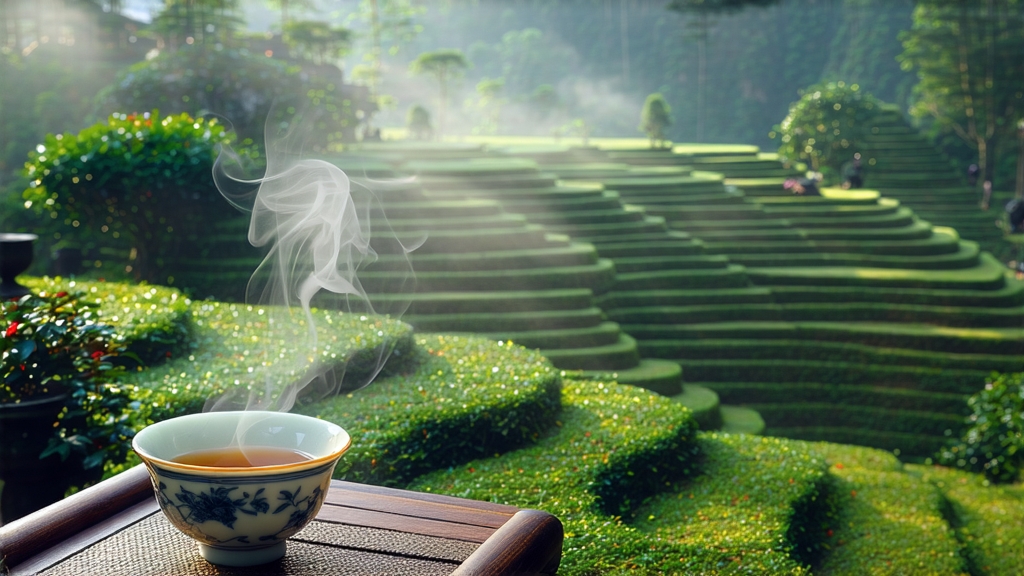
Nestled between 1,000 and 1,400 metres above sea level, the Alishan mountain range in central Taiwan is rarely pictured without its famous ocean of clouds. Those same clouds act as a natural shade cloth, filtering intense subtropical sunlight into soft, diffused rays that slow leaf growth and coax the bush into producing some of the most fragrant oolong teas on earth. Alishan High-Mountain Oolong—often shortened simply to “Alishan”—is therefore less a brand name than a geographical promise: every sip carries the cool moisture of perpetual mist, the sweetness of wild mountain flowers, and the minerality of ancient forest soil.
Historical roots
Oolong processing arrived in Taiwan during the mid-nineteenth century when tea growers from Fujian’s Anxi and Wuyi counties crossed the strait, bringing Qing-era cultivars and charcoal-firing techniques with them. Alishan itself remained a forestry reserve until the 1970s, when new highways finally allowed farmers to plant tea on previously inaccessible slopes. Because the mountain sits on the Tropic of Cancer yet enjoys alpine night temperatures, bushes mature slowly, developing more amino acids and less tannic bitterness than their lowland cousins. Within two decades Alishan oolong had eclipsed much of Taiwan’s earlier “Baozhong” fame, becoming the flagship high-mountain style sought by collectors from Tokyo to Toronto.
Cultivar and terroir
The overwhelming majority of Alishan gardens are planted with Qing Xin (literally “green heart”), a tender, small-leaf cultivar originally transplanted from Fujian. Qing Xin thrives in thin, well-drained lateritic soil rich in iron and quartz; its shallow root system forces the plant to mine trace minerals from bedrock, translating into a cup with pronounced stone-fruit and flint notes. Diurnal temperature swings of 10–15 °C cause the leaves to manufacture extra geraniol and linalool, the same aroma compounds found in rose and jasmine, giving Alishan its signature “milky-floral” bouquet that lingers like high-end perfume.
Plucking standard
Only the apical two or three leaves plus the dormant bud are taken, always by hand between late March and early May for spring tea, and again in late October for the subtler winter harvest. Experienced pickers finish before 10 a.m., while dew still glistens, ensuring leaves remain cool and turgid for the long withering process ahead. A single mu (0.16 acre) of terraced Qing Xin yields barely 25 kg of finished tea, explaining why top-grade Alishan can command over US $200 per 600 g.
Crafting the leaf: the 24-hour choreography
- Outdoor withering: baskets of leaves are spread 3 cm thick under shaded bamboo racks. Ambient mountain air, 18 °C and 75 % humidity, allows gradual moisture loss without bruising. Every 20 minutes the tea master fluffs the pile, coaxing grassy volatiles out while inviting a whisper of enzymatic oxidation.
- Indoor withering & tossing: once the leaf edges feel leathery, the batch is moved onto waist-high bamboo trays and gently tossed for 3–5 minutes. This bruises the margins just enough to trigger polyphenol oxidase, turning edges reddish while the veins stay green—classic “green belly with red skirt” oolong biochemistry.
- Bruising cycle: five to seven toss-rest cycles follow, each rest lasting 45 minutes. Oxidation hovers between 20 % and 30 %, far lighter than the 50–70 % of Fujian rock oolongs, preserving bright, alpine aromatics.
- Fixation: a 230 °C drum roast for 3 minutes kills the enzymes, locking in the desired oxidation level and evaporating residual grassy notes.
- Rolling: while still warm, leaves are wrapped in canvas and compressed under 30 kg granite blocks for 5 minutes, released, then re-wrapped—up to 30 repetitions. This alternating pressure twists the cell walls so violently that aromatic oils migrate to the surface, ready to bloom in your cup.
- Ball-rolling: the most recognisable Taiwanese innovation. The semi-dry leaf is packed into nylon cloth bags the size of grapefruits and tumbled in a rotating drum with 40 rpm for 10 minutes, followed by 60 °C low-bake for 20 minutes. Cycle repeated 25–35 times over 6 hours compresses the leaf